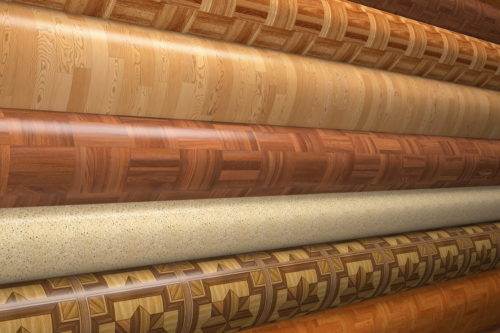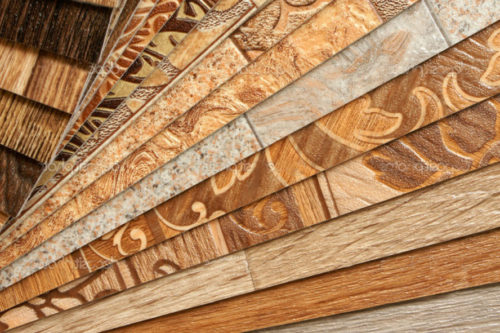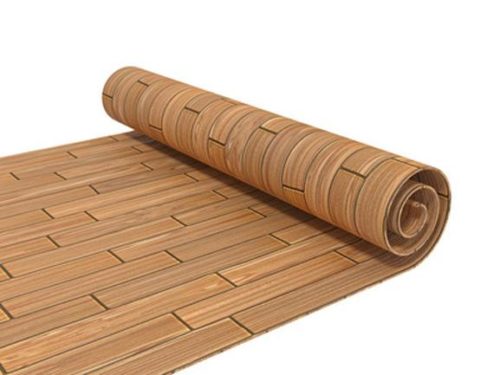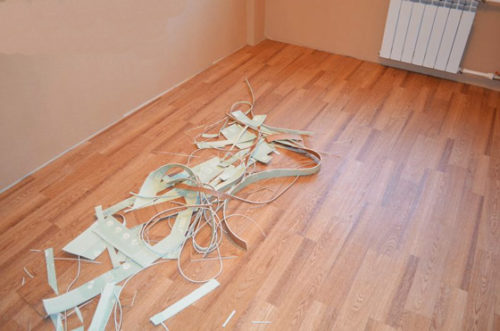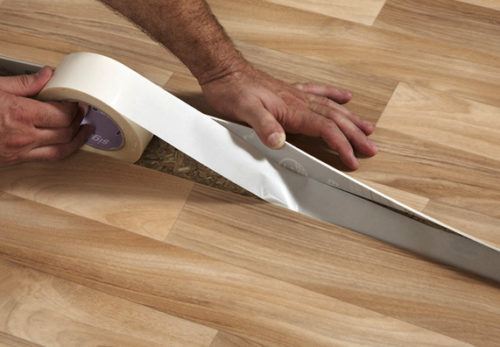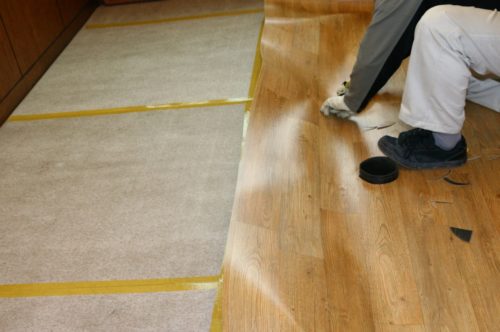During the time of mass construction, there was a problem of providing premises inexpensive, but at the same time high-quality and beautiful flooring. Wooden parquet and floorboard are pretty roads and workors in the laying, besides, they are very picky in the future maintenance. The output was found in the form of a linoleum.
Content
Linoleum is a rolled material from natural or synthetic substances, which has a large number of advantages over the other floor coatings. The use of advanced technologies in the production of this coating allows you to make it with a wide range of patterns and textures - from a homogeneous to imitation of the parquet board. Due to this, you can choose the most suitable pattern for a specific design room. On how to install linoleum with your own hands - further in the article.
Types of linoleuma
Currently, in almost any general construction or specialized building materials store, a large number of types of linoleum are available. In order to correctly choose the necessary coating, it is necessary to know its properties:
- Natural linoleum. Despite the fact that it is customary to consider this material purely artificial, there are similar coatings from natural fibers. They are made on the basis of wood resin, plugs, lime and flaxseed oil. The most important advantage of natural linoleum is its environmental friendliness, fire safety and resistance to bacteria. Also, the surface of the material does not absorb fatty spots, which makes it almost perfect coating for the kitchen. The disadvantage of natural linoleum is, first of all, the price, as well as the monotonance of the drawings.
- Rubber linoleum or Relin. It is manufactured based on bitumen or crushed secondary rubber. The upper coating of the Reline is made of rubber fibers. The color of the linoleum gives various pigments. Due to such a combination, the coating has excellent moisture resistance and plasticity and can be successfully used in rooms with high humidity.
- Colllyline or nitrocellulose linoleum. Single-layer coating, which is based on nitrocellulose. Due to the presence of only one layer, the material has excellent elasticity. Also, its surface is very good. The disadvantage of nitrocellulosic linoleum is a high fire hazard due to the low flammable temperature.
- Alkyd or garbage linoleum. The substrate of this material is a woven material, and the surface layer is represented by a mixture of alkyd resins and painting pigments. Due to this, the alkyd linoleum has excellent noise and thermal insulation. However, it is considered the most fragile among all types of this coverage.
- PFC (polyvinyl chloride) linoleum. The most common and popular material for floor covering. It is produced on several bases: tissue, nonwoven and foamed bases. The advantages of PVC-based linoleum: moisture resistance, wear resistance, good thermal insulation (for multi-layered species), low price.
PVC Linoleum is distinguished by the place of use:
- Domestic. Coating with a thickness of about 4 mm. It has mediocre wear resistance, while has a low price.
- Semi-commercial. It is used in places of low or medium patency. A special protective coating with a thickness of up to 0.7 mm is applied to the surface of such a linoleum.
- Commercial. Fixed in places of high passability. The thickness of the protective coating in them reaches 2 mm, which allows you to withstand high mechanical loads.
Also linoleum differs in the number of layers in its structure.
- Homogeneous linoleum. It is a homogeneous structure, which consists of granulated polyvinyl chloride and coloring substances. Such material is characterized by the fact that its drawing is not on the surface, but passes through the entire layer, so it is the same on both sides. Such a structure determines the excellent performance characteristics of homogeneous linoleum.
- Heterogeneous linoleum. The material may consist of several PVC layers, which are based on fiberglass.
- Domestic linoleum. No foundation (substrates). Due to the small thickness is short-lived and demanding for the preparation of the surface.
- Basic linoleum. The type of material that has a thermal insulation base of tissue or nonwoven material.
Preparation of the surface for laying linoleum
Before laying any floor covering on the floor surface, it must be prepared. It must be homogeneous and smooth.
Linoleum laying is carried out practically on any coating: on a concrete tie, wooden floor, etc.
Terms of surface preparation:
- Concrete screed is the most suitable coating for laying linoleum. Before starting work, it is necessary to check the absence of cracks and elevated on the surface of the screed. If damage is not significant, they are ground, sweat and grind. Otherwise, the screed must be broken and fouled again. After the screed is repaired, a self-leveling mixture is poured onto the surface of the floor. It will make the surface more smooth.
- With a wooden surface problem more. First, it is necessary to make a revision of the lag, since the floor under the linoleum should be strong and not "walk". Secondly, you need to make sure that the floor boards do not contain signs of rot, fungus or mechanical destruction. All "bad" boards should be urgently replaced.
- To finally align the floor, the plates of plywood are stacked on top of the boards, the thickness of which should be at least 6 mm. They are attached to the gender boards with the help of self-tapping screws whose heads are hiding in vision. They, like gaps between the plates, are closed with a putty.
Some builders to save time, laid a new linoleum on the old one. This is categorically not recommended.
Required tool and materials for laying linoleum
In order to carry out such work independently, you must have the appropriate tool:
- A sharp knife for floor coverings.
- Spatula for applying glue.
- Roller with teeth.
- Hammer.
- Roulette, ruler, felt-tumb.
Materials will need:
- Glue, if it is necessary to glue the linoleum.
- Screws, nails.
- Double sided tape.
Linoleum Installation Instructions
Instructions for the installation of linoleum as follows:
- The first thing is to cut the linoleum, while it is necessary to do this with the picture on the surface of the coating.
- The cutting sections of the coating are laid out in the room for 2-3 days. During this time, it should straighten under its own weight. The room temperature should be at least + 18 ° C. Otherwise, the material will not straighten. The same conditions are necessary in the process of laying.
- The primer is applied to the surface of the floor.
- After drying the primer, special glue is applied to the prepared coating. This is done using a toothed spatula. Apply glue to the floor surface must be as uniform as possible. Material consumption per 1 m 2 Must meet the requirements of the manufacturer, which are indicated on the package.
- Next, put the linoleum on the floor and smooth using a rink or special ironing, which should remove air from under it.
- There are several ways to install linoleum. So, for example, some experts prefer to lay linoleum on bilateral scotch. First, it is glued onto the canvas, and then together with the material laid on the floor surface. Glue the tape to the linoleum canvas is necessary around the perimeter and diagonally. Must be sure to ensure that there are no folds and bugs.
Linoleum Installation Rules and Technology:
- It is necessary to strictly observe the mode of temperature and humidity in the room. The temperature should be at least + 18 ° C, and the humidity is not more than 4%. Reducing the temperature and increase in humidity can cause the coating from the surface.
- It is impossible to lay linoleum on the surface, which has large height differences and loose joints between the overlap panels.
- Linoleum needs to be laid on the final stage of repair work.
- Processing of the primer surface is required.
- Linoleum junctions are necessarily processed by welding (cold or hot) or decorative moldings.
- To get a smooth junction, two canvases put the brackets, and then cut under a smooth board.
Welding of linoleum beans
In order for the joints between the canvas to be durable, their edges are welded. For this I use two technologies: hot and cold welding. The first provides a very durable junction, so it is mandatory used when laying a commercial linoleum. For this purpose, a special burner with a compressor is used. It serves air, which, passing through the heating spiral, heats up to a high temperature and saves the edges of the linoleum. The process passes with the use of wire. It is possible to carry out the welding of seams only on a well-attracting material, so after sticking you need to withstand at least a day.
Cold welding is carried out using a special glue. It happens two types:
- Type A - applied to fresh linoleum.
- The type C, which has a more dense consistency, is used for welding long sheets.
The effect of glue is very simple - it enters the seam, and melts the edges that sold out with each other.


